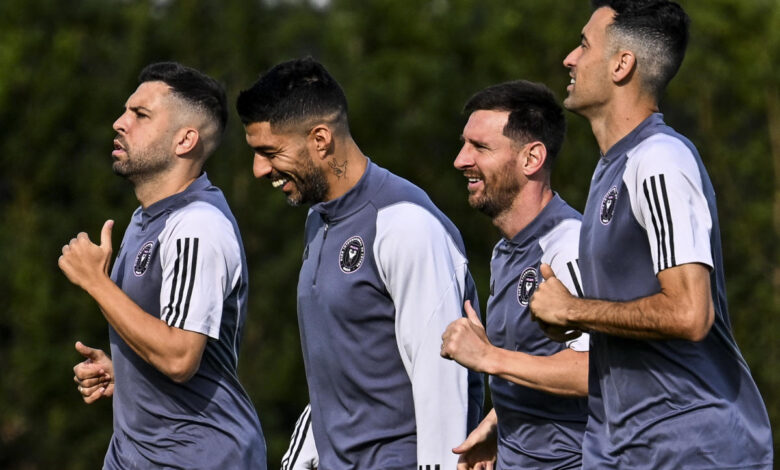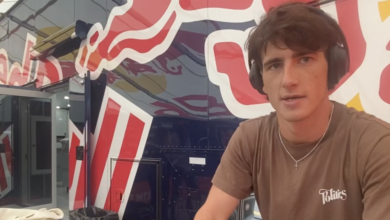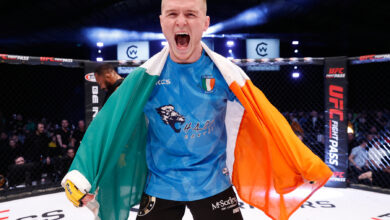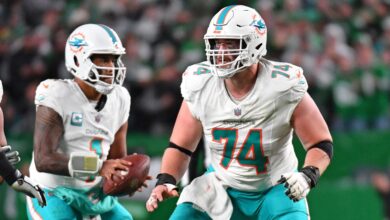Does Lionel Messi speak English? He’s learning, but at bilingual Inter Miami, he hardly has to

Julian Gressel prepared for life at Inter Miami like any new Lionel Messi teammate would. First, he went for a run. Next, he binged old Barcelona highlights on YouTube. Then he sorted through a move to South Florida in January, as Inter’s second offseason signing. And before long, he bought a subscription to Babbel, the language-learning software.
Gressel, a German American midfielder, had picked up pinches of Spanish throughout his seven years in Major League Soccer. He maintained a Duolingo streak that recently hit 1,000 days. His Miami move, though, was impetus to get serious. He now sits down for two or three Babbel lessons each day. On his morning commute, he queues up a Spanish-learning podcast, and turns his Porsche Cayenne E-Hybrid into what he calls a “Spanish school on wheels.”
Because once he arrives at Inter’s Fort Lauderdale facility, most of his colleagues will be speaking en español.
Head coach Tata Martino conducts training sessions in Spanish. Assistant coach Javi Morales reiterates key instructions in English, but many of Inter Miami’s two dozen players don’t need the translation. Messi, Martino, his Argentine staff, and a wave of nine new Hispanic players have transformed an already-bilingual club into a Spanish-first team.
And as they transformed, non-native speakers raced to keep up. Some, according to Morales, committed to classes. Others downloaded apps. Some practiced vocabulary or verb conjugations alongside soccer.
None of it was mandatory. Motivation, though, was obvious.
“If Lionel Messi’s coming to your team,” Morales told Yahoo Sports, “you’d probably want to be able to communicate with him.”
Messi, who spent the first 34 years of his life in Argentina and Spain, has never spoken English publicly — not even in his Super Bowl commercial. At Inter Miami, he almost exclusively speaks in his native tongue, swallowing consonants as ever. When players huddle in their locker room prior to matches, Messi sometimes sermonizes in Spanish. In their early days of preseason, Gressel asked him, Do you know English? Messi responded, No, not really. Your Spanish is probably better than my English.
But then, in late January, during the second half of a friendly against Saudi Arabia’s Al Hilal, Messi approached Gressel, cupped a hand over his mouth, and detailed a tactical tweak.
“Now, we change. You stay, and Jordi [Alba] runs, Jordi goes more in behind,” Messi told Gressel — in English.
Later, according to Gressel, Messi approached again, and elicited a smile: “English, pretty good, no?”
Messi, according to teammates and Morales, has been learning, gradually. “He’s taking English lessons,” Finnish winger Robert Taylor said last summer. “Still, the conversation level isn’t great, but, on the field, it’s different.” DeAndre Yedlin confirmed at the time that it was “not a whole ton of English, but it’s enough to get by.” Gressel told Yahoo Sports this month that it’s still “not too much, but … he’s kind of been warming up to it a little bit. … He’s trying to say words in English. He’s asking me sometimes what [something] means, or if he said it the right way.”
Gressel has been trying to teach Messi, and “it hasn’t gone that well,” Gressel said with a smile on his podcast. “But, I’ll keep at it.”
Messi’s friends, on the other hand, are more advanced. Luis Suarez arrived in December with plenty of English already in his arsenal. Sergio Busquets “speaks and understands English really well,” Gressel says, so the two of them converse — about tactics, about family, about MLS, about the players’ association.
They could try to converse in Gressel’s blossoming Spanish; but “I know that he wants to speak [English], and he wants to get better at it,” Gressel says of Busquets.
When Messi, Busquets and Jordi Alba joined Inter Miami last summer, Busquets “was the one facilitating everything, and translating,” then-Miami defender Kamal Miller told Yahoo Sports.
Alba also “started English lessons right away, and in five, six months … night and day,” Miller said. As the most outgoing of the Fantastic Four, Alba’s personality has lent naturally to language learning. His progress has been relatively rapid.
Their efforts are appreciated by the native English speakers, who, in turn, to varying degrees, are absorbing Spanish. And barriers — already bridged by several bilingual staffers and players — are giving way to bonds.
“Language,” Morales says, “is a link.”
Navigating the multilingual pitch
Language barriers have been inescapable in international soccer for decades, and especially throughout the 21st century, as the game globalized. Morales, a playmaking midfielder from Argentina, first encountered one in 2007, when he moved from sunny Spain to snowy Utah, to join Real Salt Lake.
He knew only a few English words at the time; and the club employed only a few Spanish speakers. Morales recalls one Mexican staffer in the front office who’d occasionally help, and one teammate who’d translate individual instructions. But hundreds of English words would whiz over his head. “I didn’t understand anything in the meetings, in the tactics work,” Morales remembers. “I just was playing, doing my thing on the field.”
He also struggled away from soccer — at restaurants, at the bank, in a state where less than 10% of residents spoke Spanish. So he set off on a yearslong language-learning journey. He began with homemade English lessons, taught nightly by his wife. He graduated to a language school, and tried a big-group class. Eventually, he decided to pay out of pocket for a 1-on-1 tutor.
Hundreds of players have replicated that journey in MLS. More than 300 currently on rosters were born in countries where the primary language is something other than English. Upon arrival in the United States — where over 90% of the population speaks English “very well” or better — some have taken it upon themselves to learn. Others have spent hours in classes or private lessons arranged by their club.
A year ago, Sergii Kryvstov was one of the many. After 13 years at Shakhtar Donetsk in his native Ukraine, he signed with Inter Miami last January. As he prepared for his transatlantic move, he found a multilingual Ukrainian who could teach him English via Zoom, two afternoons per week. He touched down in Miami equipped with basic phrases. When he hopped in an Uber, he tried to use them.
“No hablo ingles,” his driver responded.
Kryvstov was confused, but soon came to understand that in South Florida, Spanish is just as prevalent and useful. At stadiums and rail stations, at coffee shops and stores, an eclectic blend of Spanish and English (and even Haitian Creole) narrates everyday life. In Miami-Dade County, roughly 66.2% of residents speak Spanish; 65.7% speak English. Morales, who’s now fluent in English but still more comfortable in Spanish, says he’ll go entire days without speaking English other than at the team facility; and in general, his rough language-usage split is 20% English, 80% Spanish.
In Inter’s academy, Morales says, around 80% of the teens he coached were bilingual. The senior team that he and Kryvtsov joined last winter, however, was a bit less so. Under British head coach Phil Neville, English was the dominant language. Spanish helped some foreigners connect with Latino teammates, but it never felt necessary.
Then, on June 1, Neville got fired.
On June 7, Messi said “voy a ir a Miami.”
Martino followed later that month. And Kryvstov asked his teacher, who’d fled the war in Ukraine to Spain: Can we do 45 minutes of English, then 45 minutes of Spanish?
Martino, like Messi, had spent all but three years of a long soccer life in Spanish-speaking countries. His managerial journey wound through Argentina, Paraguay and Barcelona. When he arrived at Atlanta United in 2016, Martino understood a bit of English, but not enough to impart all his wisdom on players. So he tabbed assistant coach Dario Sala to translate team talks. He relied on bilingual players to relay commands. And five years after leaving Atlanta, he reproduced the system in Miami.
Martino brought with him a staff of trusted assistants, but retained Morales as part-coach, part-interpreter. The directive, Morales explains, is not to restate everything Martino says; it’s to convey meaning, succinctly, but precisely when necessary. He doesn’t need to translate off-topic quips. He doesn’t worry about going word-for-word. But he stands next to Martino in meeting rooms or on training fields, and when the head coach finishes, a few dozen eyes shift; Morales gets the floor.
A swelling majority of Miami’s players, however, can understand Martino. Gressel aside, every new signing of the Messi era has hailed from Spain or South America. The non-Spanish speakers, meanwhile, are getting up to speed — some by studying Spanish, but also by what Gressel calls “intentionally listening.”
“When I was really trying to listen and understand what he was saying in Spanish, it actually felt easier to understand the more I did it,” says Chris McVey, an American Swedish defender recently traded to D.C. United. McVey, 26, had been learning Spanish off and on, in classrooms and online, ever since he was a teen. But ingesting it daily, and regularly trying to speak it, helped him accelerate.
Mastering it, of course, requires years of effort. Some players — Spanish speakers and English speakers, in Miami and elsewhere — aren’t willing to sacrifice the time and energy. “They want to learn,” Morales says, “but they don’t want to go through the process. That process means a lot of work, a lot of hours, dedication.”
Those who have put in the work, though, have found fulfillment — and fútbol benefits.
Bilingual bonds connect teammates in Inter Miami and beyond
In those whirlwind early days of Messi-mania, in Inter Miami’s inner sanctum, Messi and Busquets would chat, about life and soccer — and Kamal Miller, a Canadian international with an adjacent locker, would sometimes stare, blankly, in silence.
His Spanish was limited. His head would spin.
“I can’t just sit here and not speak,” Miller thought to himself.
“So I had to learn a bit,” he told Yahoo Sports this offseason, a week after Miami traded him to Portland. “I was walking around the facility with my phone and an app, just practicing words and stuff like that. And it paid off.”
It pays off on the field, where Inter Miami players bark in both English and Spanish. Basic soccer terms, such as “turn” and “time,” quickly become ingrained in bilingual vocabularies.
Perhaps more importantly, it also knits a team together.
Several Miami players are proficient in both languages. Among the best, according to Morales and players, are Suarez, Busquets, Ecuadorian striker Leo Campana, Argentine American midfielder Benjamin Cremaschi, Honduran American midfielder David Ruiz, and American midfielder Lawson Sunderland. They help unite a squad that otherwise might drift into English- and Spanish-speaking cliques.
At the intermediate level, too, effort helps illuminate personality. Gressel will try his Spanish, and “even if I say something wrong, the reactions I get are always pretty positive,” he says. “Even if it’s funny, it’s still in a good way.”
He has tried so much that, on an almost daily basis, Alba will spew a string of Spanish at him. “Sometimes,” Gressel says, “I get it.” Other times, his eyes will glaze, and Alba will pause. “No understand,” Alba will say. Gressel will confirm. They’ll both laugh.
And those laughs are meaningful. They’re meaningful in Miami and beyond, especially for players surrounded by a foreign language in a foreign land.
“Even if you can just have a little smile with some of those guys that don’t speak much English, it’s extremely helpful to connect as teammates,” Gressel says. And on a personal level, “it’s absolutely rewarding, and makes me feel good, and makes me feel more integrated.”



